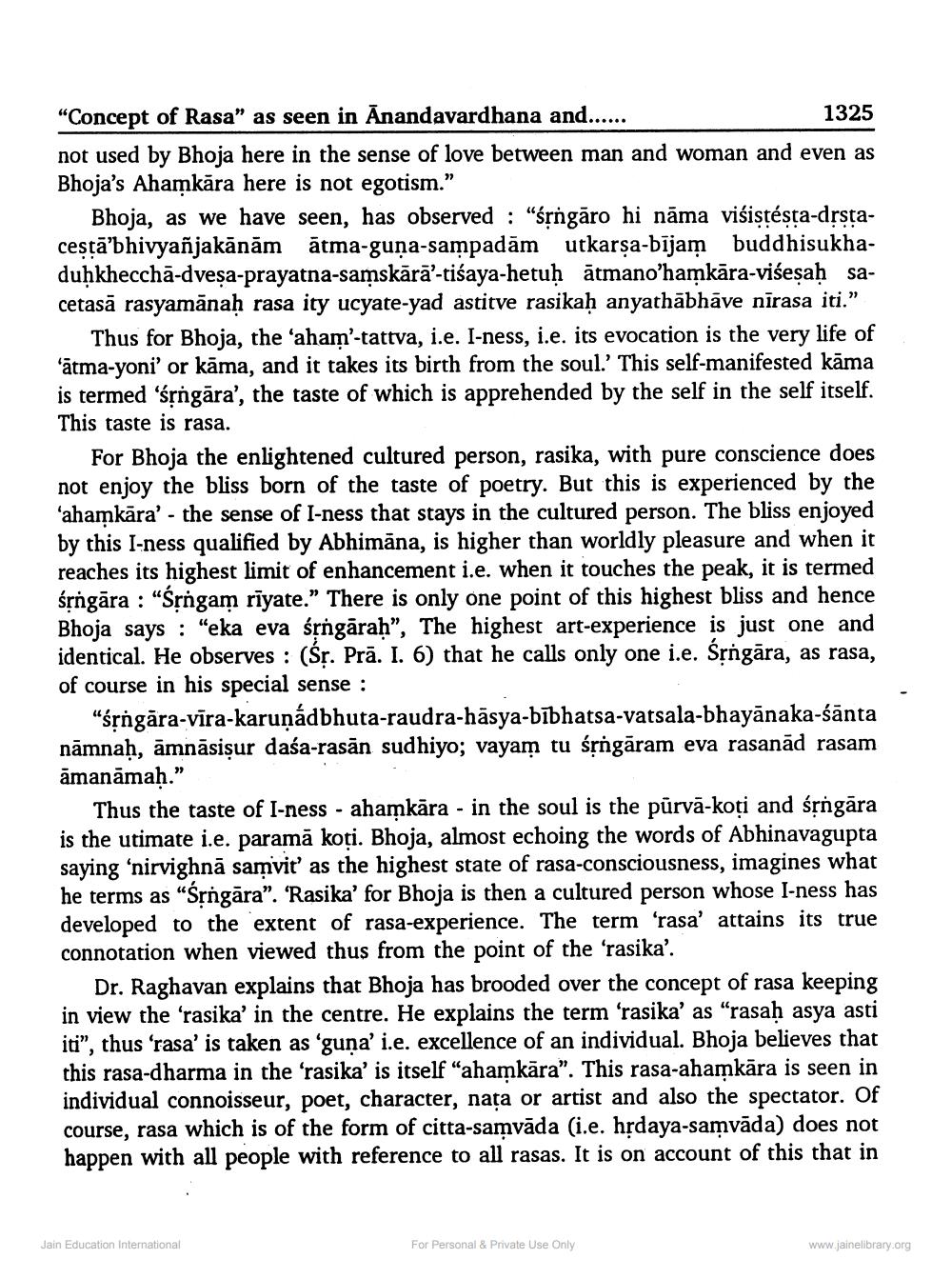________________
“Concept of Rasa" as seen in Anandavardhana and......
1325 not used by Bhoja here in the sense of love between man and woman and even as Bhoja's Ahamkāra here is not egotism."
Bhoja, as we have seen, has observed : “śngāro hi nāma visistésta-drstacestā'bhivyañjakānām ātma-guna-sampadām utkarsa-bījam buddhisukhaduḥkheccha-dveșa-prayatna-samskārā’-tiśaya-hetuḥ ātmano’hamkāra-viśesaḥ sacetasā rasyamānah rasa ity ucyate-yad astitve rasikaḥ anyathābhāve nīrasa iti.”
Thus for Bhoja, the ‘aham'-tattva, i.e. I-ness, i.e. its evocation is the very life of 'ātma-yoni' or kāma, and it takes its birth from the soul.' This self-manifested kāma is termed 'śrngāra', the taste of which is apprehended by the self in the self itself. This taste is rasa.
For Bhoja the enlightened cultured person, rasika, with pure conscience does not enjoy the bliss born of the taste of poetry. But this is experienced by the 'ahamkāra' - the sense of I-ness that stays in the cultured person. The bliss enjoyed by this I-ness qualified by Abhimāna, is higher than worldly pleasure and when it reaches its highest limit of enhancement i.e. when it touches the peak, it is termed śộngāra : “Sțngam riyate.” There is only one point of this highest bliss and hence Bhoja says: "eka eva śrngāraḥ”, The highest art-experience is just one and identical. He observes : (Śr. Prā. I. 6) that he calls only one i.e. Śrngāra, as rasa, of course in his special sense :
“śộngāra-vīra-karuņádbhuta-raudra-hāsya-bībhatsa-vatsala-bhayānaka-śānta nāmnaḥ, āmnāsişur daśa-rasān sudhiyo; vayam tu śộngāram eva rasanād rasam āmanāmah."
Thus the taste of I-ness - ahamkāra - in the soul is the pūrvā-koți and śộngāra is the utimate i.e. paramā koţi. Bhoja, almost echoing the words of Abhinavagupta saying ‘nirvighnā samvit' as the highest state of rasa-consciousness, imagines what he terms as “Sệngāra”. “Rasika' for Bhoja is then a cultured person whose I-ness has developed to the extent of rasa-experience. The term 'rasa' attains its true connotation when viewed thus from the point of the 'rasika'.
Dr. Raghavan explains that Bhoja has brooded over the concept of rasa keeping in view the ‘rasika' in the centre. He explains the term 'rasika' as "rasah asya asti iti”, thus 'rasa' is taken as 'guna' i.e. excellence of an individual. Bhoja believes that this rasa-dharma in the 'rasika' is itself "ahamkāra". This rasa-ahamkāra is seen in individual connoisseur, poet, character, nata or artist and also the spectator. Of course, rasa which is of the form of citta-samvāda (i.e. hrdaya-samvāda) does not happen with all people with reference to all rasas. It is on account of this that in
Jain Education International
For Personal & Private Use Only
www.jainelibrary.org




